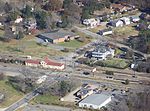Grafton Ponds Natural Area Preserve
Protected areas of York County, VirginiaVirginia Natural Area PreservesVirginia protected area stubsYork County, Virginia geography stubs
Grafton Ponds Natural Area Preserve is a 375-acre (1.52 km2) Natural Area Preserve located in York County, Virginia. It preserves Virginia's best remaining example of a coastal plain pond complex, and supports several locally-rare species including pond spice (Litsea aestivalis), Mabee's salamander (Ambystoma mabeei), barking treefrog (Hyla gratiosa), and the globally imperiled Harper's fimbristylis (Fimbristylis perpusilla).The preserve is owned and maintained by the city of Newport News, and is open for public access.
Excerpt from the Wikipedia article Grafton Ponds Natural Area Preserve (License: CC BY-SA 3.0, Authors).Grafton Ponds Natural Area Preserve
Bikeway,
Geographical coordinates (GPS) Address Nearby Places Show on map
Geographical coordinates (GPS)
| Latitude | Longitude |
|---|---|
| N 37.2 ° | E -76.5375 ° |
Address
Bikeway
Bikeway
23603 , Lee Hall
Virginia, United States
Open on Google Maps






